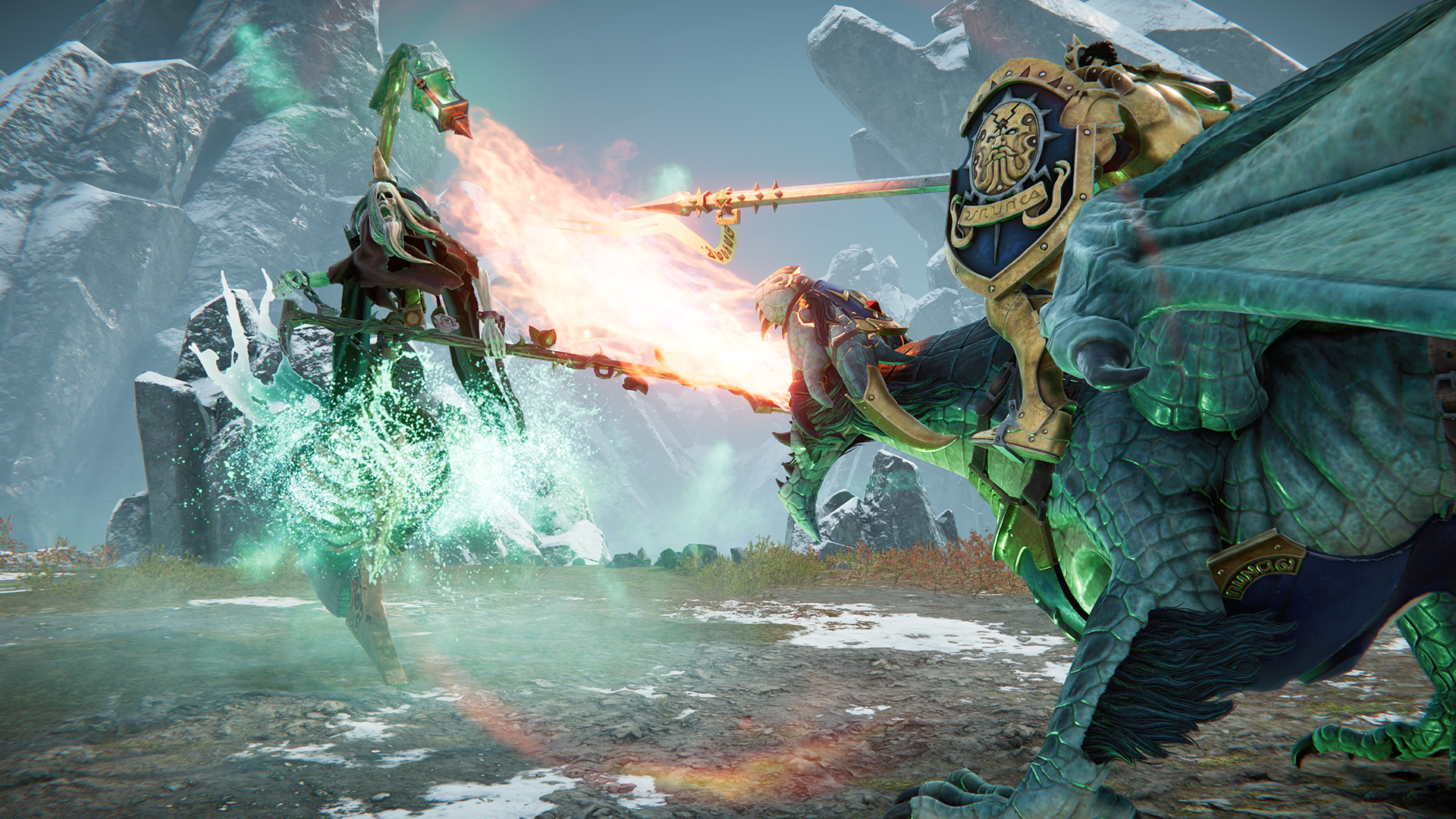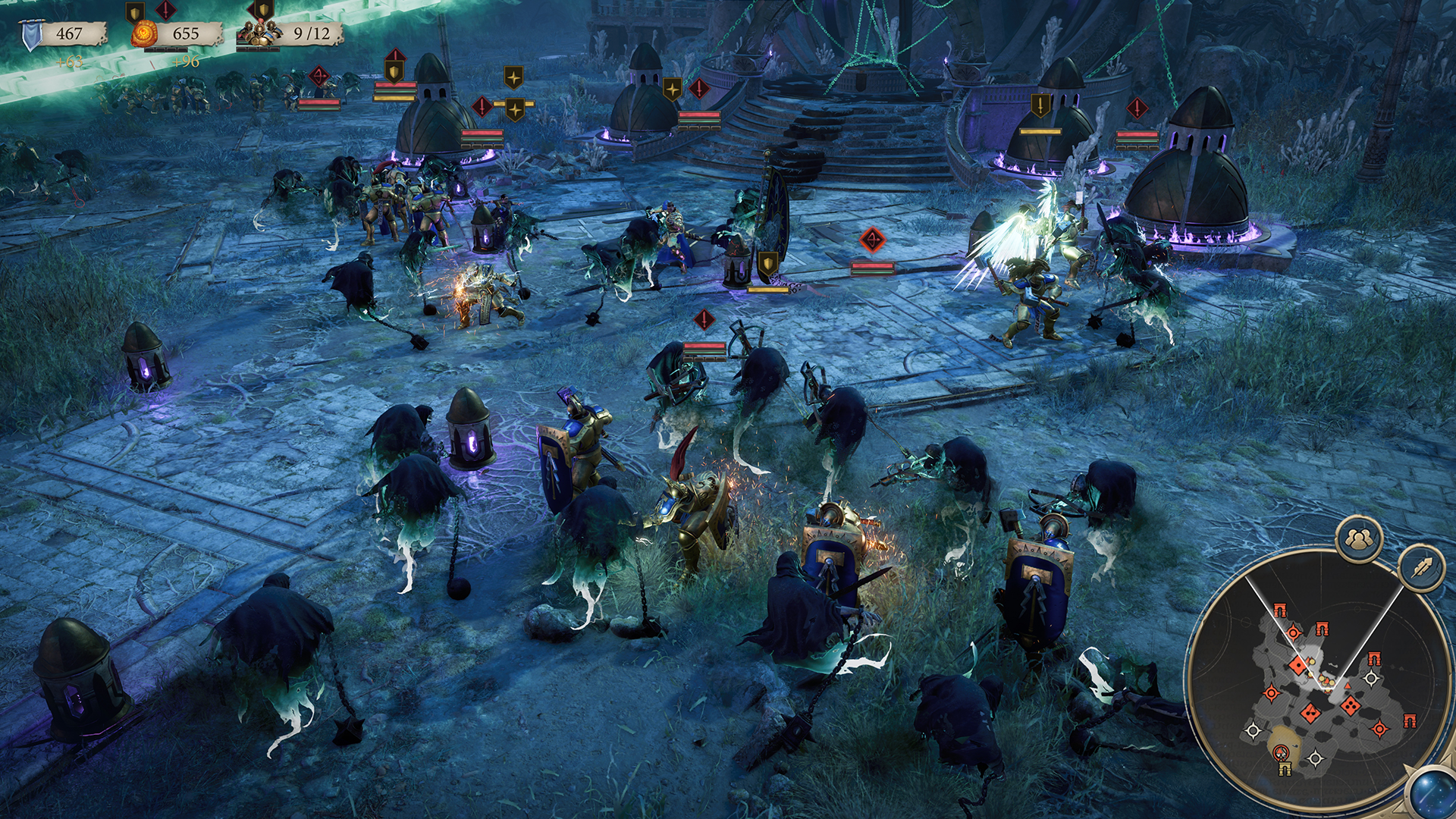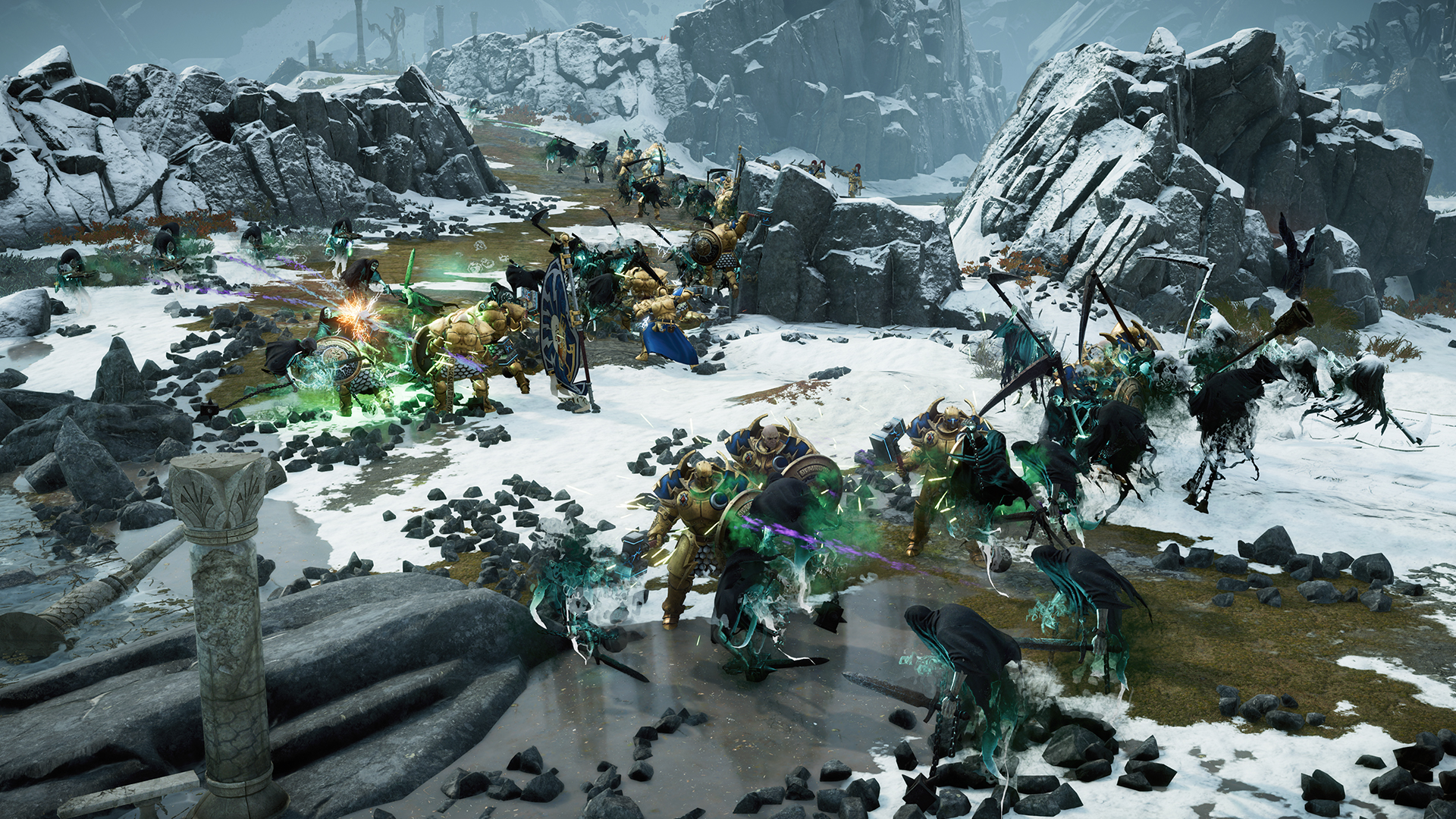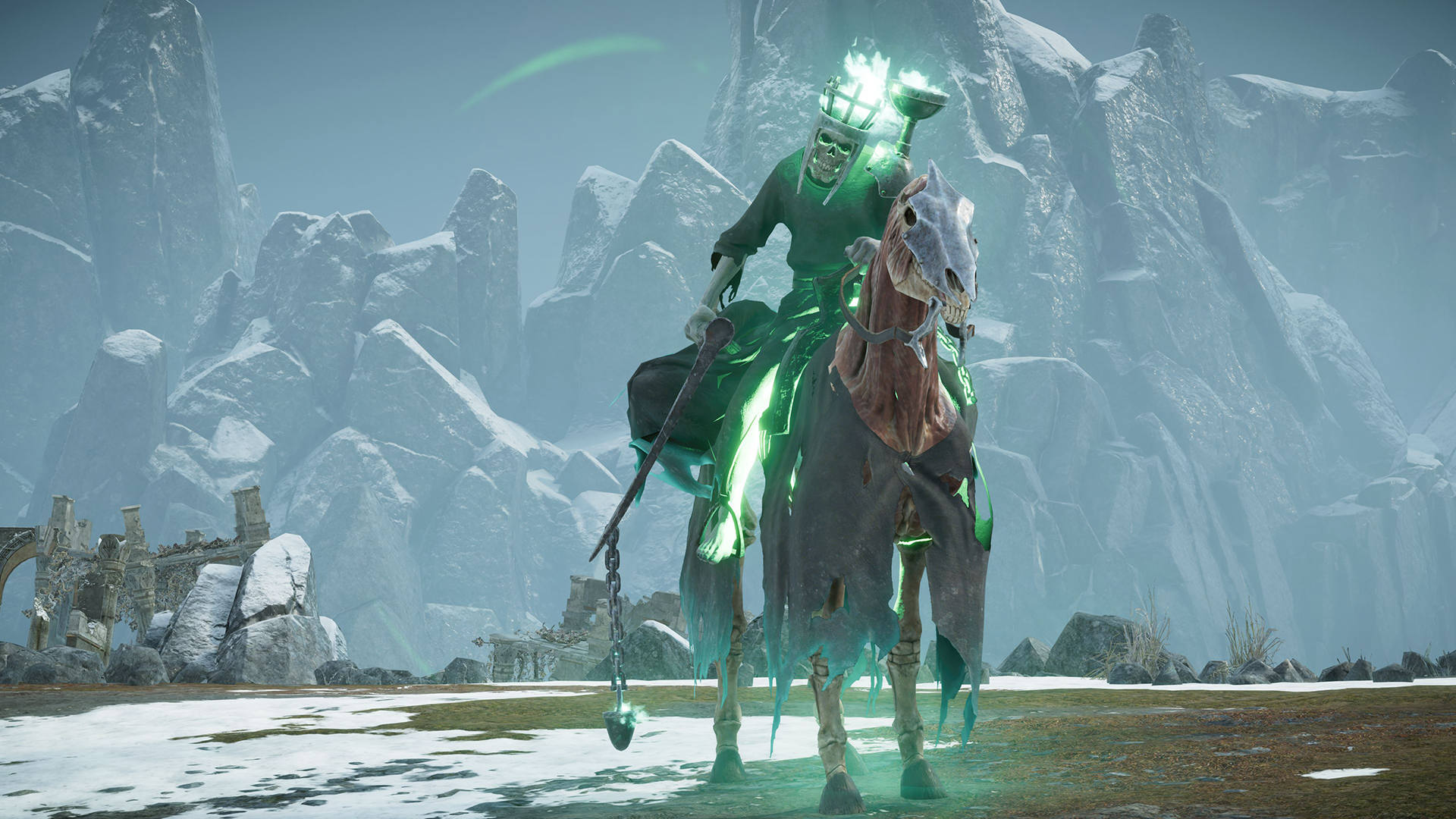Warhammer Age of Sigmar: Realms of Ruin preview - undead done right
Scare tactics

The latest faction revealed for RTS Warhammer Age of Sigmar: Realms of Ruin absolutely destroyed me.
The Nighthaunt are a horde of ravenous ghosts powered by dark magic. A newly revealed addition to this upcoming game, they’re fast, numerous and proved more than a match for me during my hands-on with the game’s third campaign chapter.
The mission itself was deliciously atmospheric. Our Stormcast Eternal heroes had stumbled upon an ancient temple which turned out to be very, very haunted. One thing led to another, and the do-gooders quickly found themselves surrounded by ghosts. Try as I might to secure the mission’s three objectives, I simply couldn’t push back the Nighthaunt tides in time.
As an RTS veteran, it was refreshing to find myself so readily challenged by a campaign mission. Though my days in Starcraft 2’s Diamond League are far behind me, my love of clicking on little people to get them to do stuff is not. Having found the 1v1 skirmish mode to be a fun, if formulaic form of PvP, Realms of Ruin’s story mission was refreshing in its demands.
In an asymmetrical battle by design, I found myself forced to think outside the box, keeping my army as mobile as possible to avoid being spread too thin. This, in itself, was enough to elevate the Realms of Ruin experience, rivaling some of the best PC strategy games out there.
It’s not enough to boast a strong economy, you must also expertly micromanage your units
Utilizing a straightforward weapons triangle system not unlike Fire Emblem: Engage, the RTS seems simple on paper. Offensive units beat defensive units which beat ranged units which, in turn, beat offensive units. However, things get tricky once you collide with the enemy. Neat battle lines swiftly become a mess thanks to a diverse range of active abilities available across the game’s units, not to mention the value of outmaneuvering your enemy. If your archers get tied up in melee, they’ll have a bad time - a fact I was forced to confront as mobile Nighthaunt units looped around my back line, exploiting my poor unit positioning.
To thrive in Realms of Ruin, it’s not enough to boast a strong economy, you must also expertly micromanage your units. By doing justice to both sides of the RTS coin, the developers at Frontier Developments have done a great deal to set the game up for success.
Get daily insight, inspiration and deals in your inbox
Sign up for breaking news, reviews, opinion, top tech deals, and more.
Ghosts in the machine

The Nighthaunt are an intimidating adversary, when it comes both to their aesthetic and the sheer number of combatants they’re able to deploy. Though we weren’t able to play as them directly in the preview build, it was clear just from fighting them that the forces of the undead play markedly differently from the two previously announced factions: the noble Stormcast Eternals and the cunning Orruck Kruleboyz.
Much like the Protoss from Starcraft 2, the Nighthaunt we faced in the hands-on had a regenerating magic shield, which made going on the offensive a necessity. Focusing fire is also a must against these unsavory undead, compelling you to stay on your toes even during more direct engagements.
Focusing fire is also a must against these unsavory undead, compelling you to stay on your toes even during more direct engagements
Speed, too, is a significant tool in the Nighthaunt’s arsenal. These are not the staggering zombies of Total War: Warhammer 3; these are creatures made of pure death magic. Sustained by mysterious, ethereal forces, the way the Nighthaunt move has a dynamic, almost fluid quality to it, setting them apart from the more traditional and familiar undead armies.
Frontier has also done a marvelous job of capturing the look of the Nighthuant swarms. The ghostly apparitions look like they’ve emerged straight from an Age of Sigmar sourcebook, faithfully recreated in all their unholy glory. When it comes to both artistic and mechanical design, Frontier has made the Nighthaunt feel like a horde, pouring across the battlefield with an unnatural agility that contrasts strongly with the Stormcast’s calm, deliberate motions
Command and control

The test build also boasted a tighter control scheme, more responsive and intuitive than we’d seen in earlier previews. Rather than feeling like a compromise to accommodate controller users, the user experience on mouse and keyboard was far more in line with traditional RTS offerings, allowing players to easily pan around the map, and select buildings and units.
That said, selecting individual units in the heat of battle would occasionally prove difficult, especially when you needed to give orders to an individual squad, rather than a group. This likely comes as a result of Realms of Ruin’s commitment to a controller-friendly experience. To the title’s credit, the DirectStep system is easily the most impressive gamepad-based setup for an RTS I’ve ever seen. However, I still harbor doubts as to whether a controller system or scheme will ever be able to match mouse and keyboard when it comes to ease of control.

As well as the DirectStep control scheme, Frontier showed off another distinguishing feature for Realms of Ruin during the preview: Conquest mode. The new mode seeks to add a roguelike element to skirmish mode, allowing players to battle through a series of missions as a faction of their choice. Each mission has procedurally generated challenges, the completion of which results in a score against which players can compare one another.
Though we didn’t get to try the new mode ourselves, the challenges and twists look exciting. Some are as simple as time limits, while others reduce unit vision and even affect movement speed. It’s a novel addition that, while not fundamental to the Realms of Ruin experience, will likely please RTS fans who are looking for extra layers of challenge.
Overall, Age of Sigmar: Realms of Ruin is shaping up to be a strong entry into the RTS pantheon. Though its preview builds are far from perfect, diverse factions and surprisingly deep unit interactions bode well for the game’s November 17 release.
Waiting for Realms of Ruin? Keep yourself occupied with our list of the best single-player games and the best co-op games.

An editor and freelance journalist, Cat Bussell has been writing about video games for more than four years and, frankly, she’s developed a taste for it. As seen on TechRadar, Technopedia, The Gamer, Wargamer, and SUPERJUMP, Cat’s reviews, features, and guides are lovingly curated for your reading pleasure.
A Cambridge graduate, recovering bartender, and Cloud Strife enjoyer, Cat’s foremost mission is to bring you the best coverage she can, whether that’s through helpful guides, even-handed reviews, or thought-provoking features. She’s interviewed indie darlings, triple-A greats, and legendary voice actors, all to help you get closer to the action. When she’s not writing, Cat can be found sticking her neck into a fresh RPG or running yet another Dungeons & Dragons game.